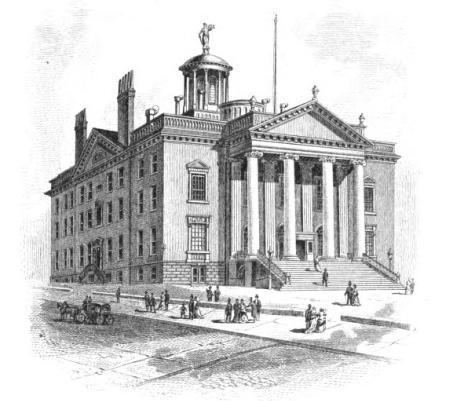Members 32 Members 128 | Party control Bucktail | |
 | ||
Term January 1 – December 31, 1827 President Lt. Gov. Nathaniel Pitcher (Buckt.) | ||
The 50th New York State Legislature, consisting of the New York State Senate and the New York State Assembly, met from January 2 to December 4, 1827, during the third year of DeWitt Clinton's second tenure as Governor of New York, in Albany.
Contents
Background
Under the provisions of the New York Constitution of 1821, 32 Senators were elected on general tickets in eight senatorial districts for four-year terms. They were divided into four classes, and every year eight Senate seats came up for election. Assemblymen were elected countywide on general tickets to a one-year term, the whole Assembly being renewed annually.
On April 18, 1826, the Legislature amended the senatorial district apportionment: Delaware Co. was transferred from the 6th to the 2nd District; and Steuben Co. was transferred from the 8th to the 6th District. They also amended the Assembly district apportionment: Chautauqua, Erie, New York, St. Lawrence and Tompkins gained one seat each; and Hamilton/Montgomery, Orange, Queens, Ulster and Washington lost one seat each.
State Senator George Brayton resigned on April 18, 1826, leaving a vacancy in the Fifth District. State Senator Jedediah Morgan resigned due to ill health, leaving a vacancy in the Seventh District.
At this time, the Democratic-Republican Party was split intwo two factions: the "Bucktails" (led by U.S. Senator Martin Van Buren) and the "Clintonians" (supporters of Gov. DeWitt Clinton).
On September 21, 1826, the Clintonian state convention met at Utica; Pierre Van Cortlandt was Chairman; and Samuel Stevens and Simon G. Throop were Secretaries. The delegates nominated Gov. DeWitt Clinton for re-election; and Henry Huntington for lieutenant governor.
On October 4, 1826, the Bucktail state convention met at Herkimer; James L. Hogeboom was Chairman; and David E. Evans and Assembly Clerk Edward Livingston were Secretaries. The delegates nominated Circuit Judge William B. Rochester for governor; and Nathaniel Pitcher for lieutenant governor.
On September 11, 1826, began the affair surrounding the abduction, and probable murder, of William Morgan which led to the foundation of the Anti-Masonic Party in 1828.
Elections
The State election was held from November 6 to 8, 1826. Gov. DeWitt Clinton was re-elected, and Nathaniel Pitcher was elected lieutenant governor; for the first time in state history, the governor and the lieutenant governor were elected from opposing tickets.
Robert Bogardus (1st D.), John McCarty (3rd D.), Duncan McMartin Jr. (4th D.), Truman Enos (5th D.), Thomas G. Waterman (6th D.), William M. Oliver (7th D.), Charles H. Carroll (8th D.); and Assemblyman Benjamin Woodward (2nd D.) were elected to full terms in the Senate. Charles Dayan (5th D.) and Victory Birdseye (7th D.) were elected to fill the vacancies. Bogardus and McMartin were Clintonians, the other eight were Bucktails.
Sessions
The Legislature met for the regular session at the Old State Capitol in Albany on January 2, 1827, and adjourned on April 17.
Erastus Root (Buckt.) was elected Speaker with 74 votes against 33 for Francis Granger (Clint.).
On February 6, the Legislature re-elected U.S. Senator Martin Van Buren to a second term of six years.
On February 20, Abraham Keyser, Jr. was re-elected New York State Treasurer.
The Legislature met for a special session on September 11; and adjourned on December 4. This session was called to debate the report of the Board of Revisers of the State Statutes, originally appointed in 1824. At this time, the members of the Board were John Duer, Benjamin F. Butler and John C. Spencer.
The Legislature enacted that 34 presidential electors should be elected by popular ballot in districts (corresponding to the congressional districts), and these 34 then should co-opt two electors-at-large (to complete the number of electors which is the sum of congressmen and U.S. senators).
Districts
Members
The asterisk (*) denotes members of the previous Legislature who continued in office as members of this Legislature. Benjamin Woodward changed from the Assembly to the Senate.
Employees
Assemblymen
The asterisk (*) denotes members of the previous Legislature who continued as members of this Legislature.
